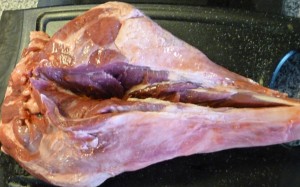Sunday 25 October 2015
I saw Chicken Shawarma being made on a TV program a couple of years ago and ‘stockpiled’ it for future use, as I thought it looked very interesting, very tempting and very ME.
Finally got round to making it a couple of weeks ago but forgot to take photos! A friend was having a party last night and a Chicken Shawarma seemed to fit the bill so had another go.
Chicken Shawarma is, dare I say it, a bit like a chicken-based Doner Kebab – the reason I say it in that way is that for some people, the mere mention of the word ‘Doner’ would be a total turn-off. Well, please don’t let it as this chicken variant is absolutely delicious and light years away from most people’s idea of the fatty, sloppy mess that is the average Doner.
First of all, it’s only similar to a Doner in that while it is made horizontally, it is cut vertically (or even made vertically and cut horizontally!). Secondly, it is made with lean chicken so not really possible for over much fat to get into it, and thirdly – actually I can’t think of a third thing but may do at some point in the future!
It is made with boned chicken thighs. It could be made with chicken breasts but they just don’t work as well as thighs. Thighs actually have more flavour and in fact, once boned and cooked, it would be difficult to tell them from breast.
One can buy boned thighs but they cost about twice as much as unboned thighs so there is a good cost justification for doing it oneself. What I like to use for this are the ‘Jumbo Thighs’ available in Asda – not sure what size of chickens they come from but I wouldn’t want to meet one on a dark night!
Boning chicken thighs is not difficult – just a routine chore that needs to be done. It gets quicker with practice so that in time each thigh will only take a couple of minutes. Most of the time I keep the bones and ‘bits’ to boil for stock as I don’t like waste.
First prerequisite as with all such jobs is a sharp, smooth-bladed knife. If you are the type who regularly hacks at meat with a blunt bread-knife, then this is not for you. Using sharp knives is so much safer – you use a lot less force and it is more controllable: downside is of course that if you are unfortunate to cut yourself, it’s going to be bad!
I sometimes wear rubber gloves to do this as the hands will get covered in raw chicken and will need to be washed thoroughly afterwards before touching anything else, particularly if it is not to be cooked (like a salad). The hands must be washed even if using rubber gloves but not such an issue as when no gloves used.
Lay the chicken thigh as shown with the cut bone nearest to you and the rounded one away,
Squeeze your fingers under the skin and separate it from the flesh. When the skin is released take hold of it and pull so that it comes away completely. Cut away any residual strips of fat.
Stick the point of the short, sharp, thin-bladed knife into the meat along the line of the bone near the exposed, rounded end. Slit the flesh down along the line of the bone.
Cut round the bone in one direction and then in the other. Use the tip of the knife to cut round the back of the bone so it is completely detached from the flesh.
Again use the tip of the knife to cut the rounded end away from the flesh so that the bone is only attached at the bottom (cut) end
Again use the tip of the knife to cut round the remaining bit of bone, taking care to also detach and remove the white kneecap-like part with all its various attached tendons/ligaments, etc.
Job done!
Follow the recipe for Chicken Shawarma and I promise that you will not be disappointed
















